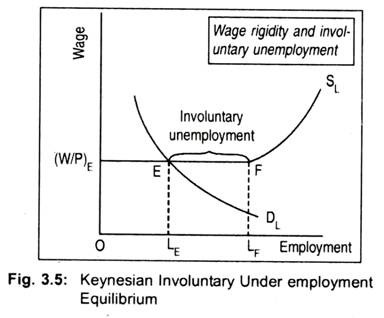Keynes rejected the classical conclusion of full employment in a capitalist economy. The worldwide depression of the 1930s gave birth to Keynesian economics.
The entire capitalist world now experienced massive unemployment problem. Keynes now forcefully argued that a capitalist economy can never reach full employment.
According to Keynes, full employment situation is a sort of astrological coincidence.
What is reality is underemployment. Thus, Keynes developed his underemployment equilibrium hypothesis rather than full employment equilibrium. If, at the going wage rate, people do not find employment a situation of unemployment emerges. Such unemployment has been called ‘involuntary unemployment’ by Keynes.
ADVERTISEMENTS:
In establishing his theory of involuntary unemployment, Keynes rejected the classical assumption of wage-price flexibility. Money wages are rigid or inflexible in the downward direction. They are flexible, however, in the upward direction. There are two reasons for wage inflexibility. First is the money illusion. Second is the institutional reason. Trade unions prevent wage rate from falling. Thus, any wage cut will be resisted. Or wage rate cannot fall below a certain level. However, there is nothing which prevents money wages from rising. Once full employment is reached, wages may rise.
This Keynesian argument suggests that labour supply function, unlike the classical system, is a function of the money wages, rather than real wages, i.e.,
SL = f (W) … (10.16)
The Keynesian labour supply function is assumed to be a function of money wage rate. However, his labour supply curve has two parts. Because of the rigid wage rate, labour supply curve is perfectly elastic. Let us assume that there is a fixed wage, W. The associated labour supply curve is horizontal in this region. Above this wage rate, money wages are free to rise. Thus, the labour supply curve (SL) in this region must be positive sloping. These two elements of labour supply curve have been shown in Fig. 3.5.
Labour demand curve, however, in the Keynesian system, is assumed to be negatively related to the real wage rate. D, curve shows this relationship.
As usual, equilibrium in the labour market is established when labour demand curve intersects the labour supply curve at its horizontal portion. Thus, point E describes underemployment equilibrium. Corresponding equilibrium real wage rate is (W/P)E. At this wage rate, LF people are willing to work while LE people are employed the difference between the two (LE – LF or EF) measures involuntary unemployment. Like the classical system, there are no automatic forces in an economy to mention full employment or to restore full employment equilibrium in the Keynesian system.
According to Keynes, wage rigidity is the cause of involuntary unemployment. This means that a free enterprise capitalist economy always fails to reach full employment because of wage rigidity. He also gave two other reasons—(i) liquidity trap, and (ii) interest inelasticity of investment—for the failure of a capitalist economy to reach the state of full employment.
Keynesian employment theory, however, gives two types of equilibria—full employment equilibrium and underemployment equilibrium.
